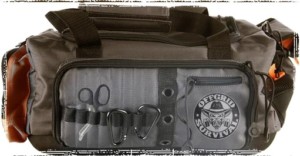
A Way to Stop bleeding and Close wounds:
Every good medical kit should have items that can be used to help stop bleeding, close and protect cuts, and help prevent infection from setting in.
When using duct tape or butterfly sutures to close a wound. Carefully clean the wound and wash out any foreign materials or debris. If you have some sort of antiseptic, apply it to the wound and dry the area. Start in the middle of the wound and apply strips to close the edges. Working your way towards the edges, gently bringing the two sides together and taping them shut.
Ways to Prevent Infection:
During a survival situation, where sanitation issues may become a problem, keeping your wounds clean and covered is extremely important. Infection can set in quickly, so you need to stay on top of any open wounds. That means it’s important to carry the following items:
Gauze
Adhesive wound dressings
Antibiotic ointments and creams
Broad spectrum oral Antibiotics – This may be difficult to come by since you need a prescription, but some doctors may be willing to prescribe them as a preventative measure if you’re going to be on an extended trip out in the wilderness. Erythromycin, Ciprofloxacin and Amoxicillin are all broad spectrum antibiotics.
Antiseptics and Disinfectants – Peroxide, Isopropyl Alcohol, PVP Iodine Ampules and Antiseptic wipes are all things that need to be in your kit.
Pain Management Items
Depending on you condition, pain can be a debilitating and even deadly thing if it causes you to lose hope or give up. Having a way to treat and manage pain, as well as decrease inflammation, is an important part of every emergency medical kit.
Aspirin
Tylenol or Ibuprofen
Codeine or some type of pain killer
Chemical Ice Bags
Lidocaine
Dealing with Allergies
Even if you don’t think you have allergies, there are certain things that can still cause an allergic reaction. In some cases, especially in people who have food allergies, allergens can cause life threatening anaphylaxis reactions that need to be treated immediately.
EpiPen or Epinephrine – For those with a life-threatening allergy, having an EpiPen with you at all times is essential. They can help stop an anaphylaxis reaction and buy you time until medical help arrives.
Items Specific to Your Unique Medical Needs
No one kit is right for every person. That’s why special attention needs to be put into developing a kit for yourself and your loved ones. I advise staying away from prepackaged kits, unless you’re using it as a foundation to build off of.
Your Kit should also contain at least some of the following items:
Emergency dental kit
Sterile needles
Surgical blades.
Splints – SAM and air splints
Quick Clot Gauze
Grooming and cleaning tools – Finger nail clippers, soap, Antiseptic wipes.
Tweezers
Scissors
Disposable thermometers
Disposable gloves
Sterile eyewash & eye dressings
Sunblock
Vaseline
Burn creams and dressings
Medical manuals and basic first aid instructions.


Leave A Comment